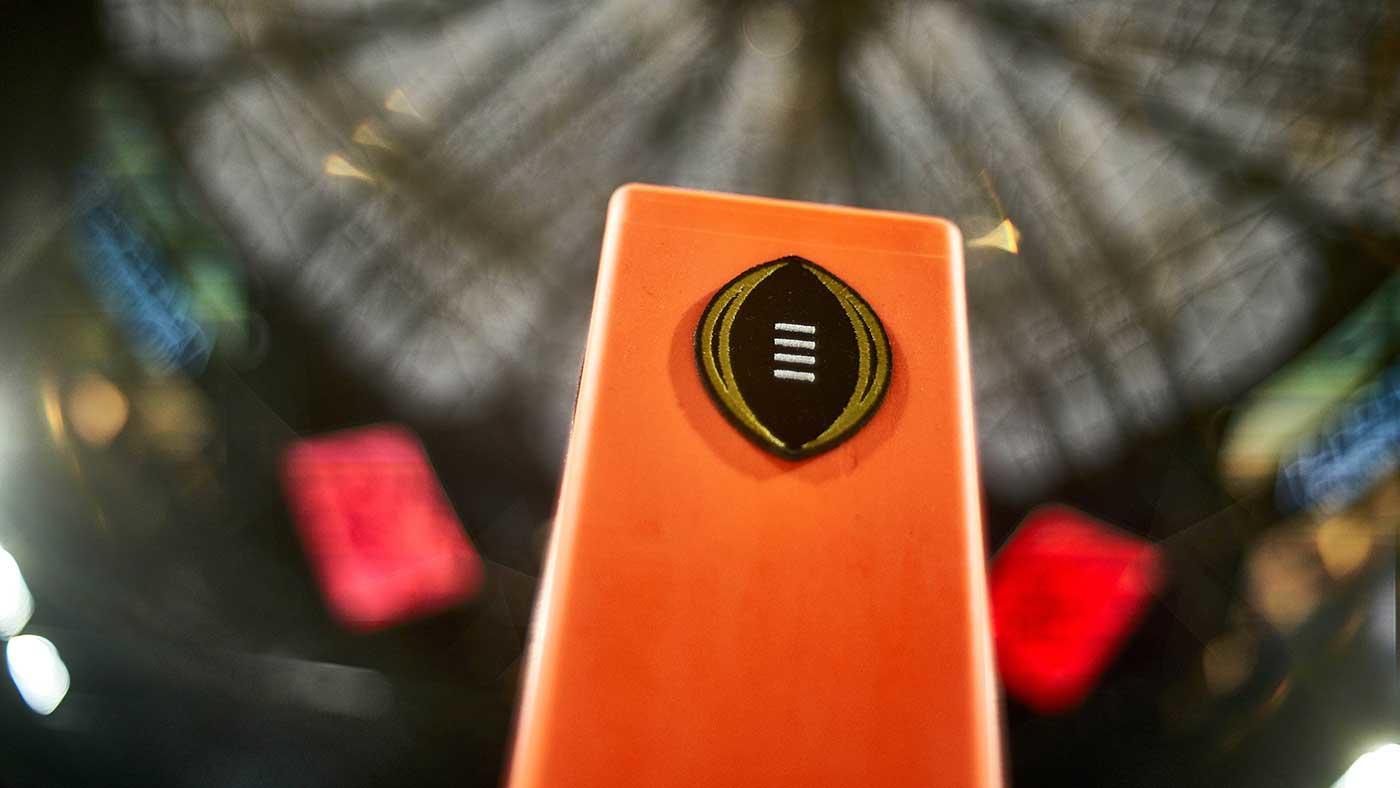Even before Knute Rockne began breaking out the forward pass as a secret weapon, college football’s biggest advantage was its element of surprise. Its appeal is basic and wonderful — built on the uncertainty of the outcome.
That’s because unscripted TV, in general, sells. And the unscripted TV that sells best is sports. In this age of screens and legalized betting, the games are almost DVR proof. You/me/we have to know now!
A College Football Playoff with automatic qualifiers becomes a little less unscripted — and a little less credible, actually. Perhaps even the SEC and Big Ten athletic directors who gather this week to discuss the playoff are unaware of that basic truth.
The two conferences are in the middle of one of the biggest flexes in the game’s history, basically running away and hiding with playoff access. In a repeat of an attempted takeover last year, the SEC and Big Ten this month are expected to once again try to secure four automatic qualifying spots (AQs) each beginning in 2026.
They have been warned of the risk. Maybe not directly, but any conference worth its media rights consultant knows the pitfalls. If the outcome in college football — heck, any sport — is known beforehand, it loses that unscripted appeal.
We’re not suggesting the outcome of individual games would be known. We’re definitely suggesting that a portion of the CFP field could be known in advance with AQs. With four Big Ten spots locked in, the likes of Iowa could be guaranteed a spot as early as Nov. 1 — a month before the season ends.
Nothing against Iowa, but that stinks. More than that, it reeks of pro wrestling.
You know, the scripted TV soap opera. Sorry, Roman Reigns and John Cena, we’re going there.
As popular as WWE might be, we still know the competition is fake. Outcomes are predetermined to further a storyline. Not that there’s anything wrong with that because pro wrestling is a form of entertainment.
So is college football, but in a much different way. Once folks start putting a finger on the scale of parity, our hallowed sport runs the risk of turning off the public. It’s one thing to have a playoff conversation about best teams vs. most deserving. It’s another knowing Iowa is going to finish in the top four in the Big Ten with a month to go. That could easily be where we’re headed.
The SEC and Big Ten last year actually floated an idea of their two champions being seeded No. 1 and No. 2 in the playoff. Those two spots would have been assured before the season started. At that point, why even play the season?
While there is no evidence such an outlandish demand will emerge this week, the discussion should remind us there is a ceiling on college football. The money train doesn’t necessarily keep rolling down the track. There is still the possibility the big dogs could screw this up.
All any sport has is its reputation. That’s why college administrators freaked out when sports betting was legalized seven years ago. All it takes is one scandal.
The CFP has prospered to this point because the teams have largely been perceived as being the right ones. There have been a few controversies (See: Florida State in 2023.) But the moment the public loses faith in the process because the Big Ten or SEC have to get that fourth team in the field, then the CFP is done.
There is evidence that all is not right. The playoff whiffed badly and stubbornly believing it could stage weeknight New Year’s Eve semifinals in 2015. Those games tanked badly in the ratings. In fact, since about Year 2, the CFP championship game ratings overall have been uneven.
Since then, the game has essentially developed two new bosses: Big Ten commissioner Tony Petitti and SEC counterpart Greg Sankey.
Their ADs meet together beginning Wednesday to continue discussions on what might turn out be a hostile takeover of the sport. Another attempt will be made at expanding the playoff to 14 teams, at least, according to Yahoo Sports. The AQs would go to SEC (four), Big Ten (four), ACC (two), Big 12 (two), Group of Five (one) and at-large (one).
Then, those expansive changes would have to be sold to the public outside the meeting room. Joe Six Pack will vote with their remotes. If you haven’t noticed, the SEC and Big Ten not only own the CFP, but they own the sport. They get most of the money, and no matter what happens, they’ll get most of the playoff berths. The rest of the bread crumbs are left for the other seven conferences.
And maybe that’s the way it should be. But with all that power comes a sense of stewardship. They can’t screw this up.
A Big Ten/SEC College Football Playoff takeover is inevitable, but what if it’s actually the best solution?
Tom Fornelli
Remember that Iowa example? At the beginning of November 2024, CBS Sports estimated that 45-50 schools were still in the running for the playoff. That assertion was backed up by the original stakeholders who actually modeled the 12-team playoff.
With eight spots already guaranteed to the two power leagues, the number of contenders has to go down. Simple math tells you that even with 14 teams, there will be less spots available.
The issue is monstrously complicated. The Power Four leagues are already so bloated their teams don’t play half the others in conference action. That now takes a period of years. In Year 1 of the 12-team bracket, that produced the discourse surrounding Indiana and its strength of schedule.
That’s why the stakeholders absolutely can’t mess this up. The warning signs continue to flash red. The latest championship game featured two bluebloods: Notre Dame and Ohio State. It was the fifth-least watched championship game since the BCS started in 1998.
Ratings are subject to a lot of influences, big and small. The CFP will be going up against the NFL more, not less, if the league decides to expand to 18 regular-season games. Playing the championship game on a Monday night continues to be a ratings challenge. One industry source said moving the Sugar Bowl from Jan. 1 on a Wednesday night to Jan. 2 on a Thursday afternoon because of the New Orleans terrorist attack cost the ratings five million viewers.
It couldn’t be helped, obviously, but what other unknowns lurk out there? Does the annual possibility of three Michigan vs. Ohio State games improve those ratings? Too much of a good thing is overkill.
And rightsholder ESPN has to make its money back some kind of way. There are already whispers the Worldwide Leader is against expansion and AQs.
All of it further guarantees disagreement in the room next week when the nine FBS conferences and Notre Dame get together for the annual CFP meetings.
“[The playoff] can’t become an invitational,” Notre Dame AD Pete Bevacqua told CBS Sports recently.
The majority of FBS conferences agree. But the SEC and Big Ten long ago wrested control of the CFP from the rank and file. Each conference gets 29% of the revenue. Do the math. That means the 100 schools and seven conferences split up the remaining 42% of the revenue.
There are reports those two leagues have weighted voting in their favor on the AQ issue. However, CBS Sports has learned there is still contractual language that requires a robust discussion on the issue among the members before any changes.
But, at the end of the day, the SEC and Big Ten could take their ball and go home — sell their rights to the highest bidder for a playoff that only includes their 34 teams. That could come as soon as the beginning of the next decade.
Those media rights would be through the roof. And, without saying it, the SEC and Big Ten are saying it: Those two leagues don’t care if those other 100 are involved. Both commissioners want more, better games. The two leagues are already talking playing each other in a series of nonconference games, which would enhance schedule strength and also playoff access.
The issue boils down to a central concern: The SEC and Big Ten don’t trust the selection committee. Actually, they don’t trust the selection committee to select enough of their teams. So they want guaranteed spots.
Some of that makes sense. The SEC and Big Ten do carry the sport and deserve weighted shares, influence and money. CBS Sports reported a year ago the Big Ten and SEC have combined to occupy 62% of 184 BCS/CFP slots since 1998.
Behind the inevitability of the Big Ten and SEC gaining access, revenue, power in College Football Playoff
Dennis Dodd

As much as the Big 12 and ACC might be against AQs, being guaranteed two spots annually — with a chance for more — isn’t a bad thing. ESPN doesn’t have to pay extra for expansion to 14 teams. Sixteen, however, is another discussion.
But why even predetermine the field if the SEC and Big Ten are strong enough to get those spots anyway in most years? Some of the answers are becoming obvious.
- With the largest conference (ever), the Big Ten needs more playoff access for its 18 teams.
- If the SEC does add a long-discussed ninth league game, it probably needs expansion and AQs. Adding that ninth game would guarantee that half the league (eight teams) would suffer a loss by playing it. Expansion and AQs cushion the blow.
For now, the SEC and Big Ten are coming for their own self interests. It’s no surprise that 3-4 teams in any league account for 75-80% of the viewership. The SEC and Big Ten are no exception. Except that industry standard has never been weaponized to this extent.
Never mind that Purdue, South Carolina, Vanderbilt, Rutgers and Northwestern would be included in this takeover. The value Ohio State, Michigan, Penn State, Alabama, LSU and Georgia bring are what makes it worth it.
But, someday, Alabama is going to wake up and ask, “Why is Vandy making the same money as we are?” Then the conferences will turn on their own and start cutting from within. That’s a different discussion for another time.
For now, the SEC and Big Ten have become quite the tag team. Let’s hope all of it doesn’t develop into Wrestlemania.
Read the full article here



























Discussion about this post